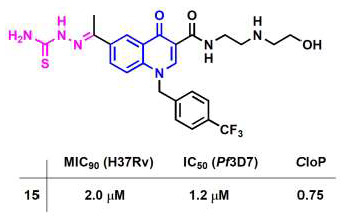New Quinolone-Based Thiosemicarbazones Showing Activity Against Plasmodium falciparum and Mycobacterium tuberculosis
Abstract
Share and Cite
Beteck, R.M.; Seldon, R.; Jordaan, A.; Warner, D.F.; Hoppe, H.C.; Laming, D.; Khanye, S.D. New Quinolone-Based Thiosemicarbazones Showing Activity Against Plasmodium falciparum and Mycobacterium tuberculosis. Molecules 2019, 24, 1740. https://doi.org/10.3390/molecules24091740
Beteck RM, Seldon R, Jordaan A, Warner DF, Hoppe HC, Laming D, Khanye SD. New Quinolone-Based Thiosemicarbazones Showing Activity Against Plasmodium falciparum and Mycobacterium tuberculosis. Molecules. 2019; 24(9):1740. https://doi.org/10.3390/molecules24091740
Chicago/Turabian StyleBeteck, Richard M., Ronnett Seldon, Audrey Jordaan, Digby F. Warner, Heinrich C. Hoppe, Dustin Laming, and Setshaba D. Khanye. 2019. "New Quinolone-Based Thiosemicarbazones Showing Activity Against Plasmodium falciparum and Mycobacterium tuberculosis" Molecules 24, no. 9: 1740. https://doi.org/10.3390/molecules24091740
APA StyleBeteck, R. M., Seldon, R., Jordaan, A., Warner, D. F., Hoppe, H. C., Laming, D., & Khanye, S. D. (2019). New Quinolone-Based Thiosemicarbazones Showing Activity Against Plasmodium falciparum and Mycobacterium tuberculosis. Molecules, 24(9), 1740. https://doi.org/10.3390/molecules24091740





